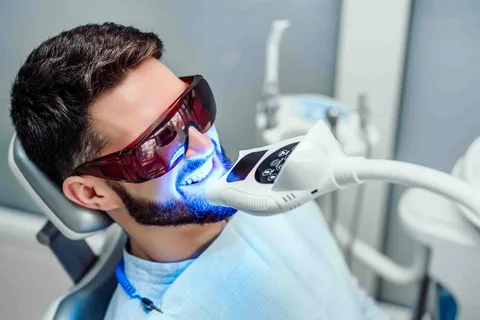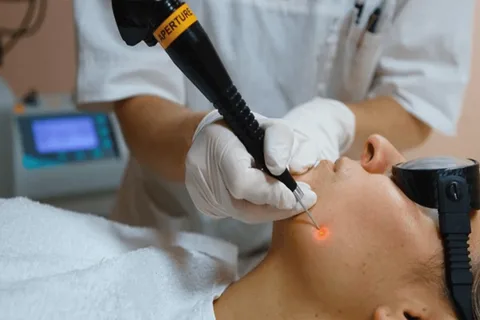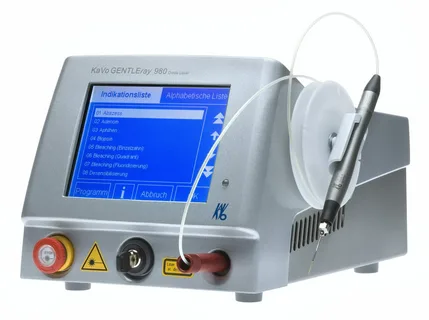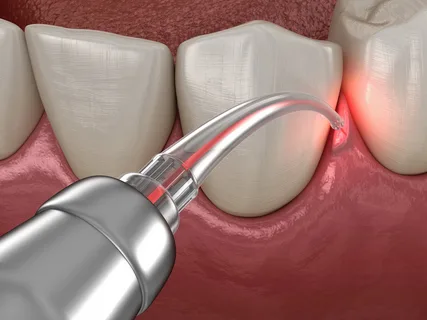Laser Radiation in Dentistry
Machine translation
Original article is written in RU language (link to read it) .
Phototherapy refers to physiotherapy techniques, based on the use of light energy from ultraviolet, infrared, and visible rays from natural and artificial sources for preventive and therapeutic purposes. Phototherapy also includes the use of laser radiation, which does not exist in nature.
About the use of laser radiation in periodontology at the webinar Lasers and photodynamic therapy in the treatment of periodontal infections and peri-implantitis.
The biological effect is exerted exclusively by absorbed energy. Visible rays have a hygienic impact, and infrared and visible rays serve as the source of light, in some cases all three types of radiation are used.
Laser Radiation
A type of light radiation characterized by its electromagnetic nature, its source is an optical quantum generator. Lasers produce monochromatic radiation, the wavelength of which can be of any optical range: infrared, visible, or ultraviolet.

Figure 1. Dissection of tooth tissues using a laser.
Laser radiation in medical practice is used at various intensities. In surgical dentistry, high-energy radiation is widely used, which is used for tissue incision or destruction. Low-energy lasers are popular in physiotherapeutic practice, they produce radiation in the infrared and red spectrum.
Laser light is absorbed by individual structural components of biological tissues, commonly referred to as chromophores. These can include:
- water,
- blood,
- pigments (melanin).
A specific laser model is designed for a particular chromophore, and the laser energy calibration is determined by the chromophore's absorbing capabilities and its application scope.
Laser in medicine is suitable for irradiating tissues for therapeutic or prophylactic purposes, surgical lasers for dissecting and coagulating soft tissues, other types of lasers for high-speed dissection or whitening of hard tissues.
The mode of operation of the laser is selected based on its power, with the following types distinguished:
- continuous,
- pulsed,
- combined.
Mechanism of therapeutic action
Today, the therapeutic and biological effects of low-energy laser radiation are still not fully understood. However, it is believed that low-energy laser radiation in the optical range is absorbed and perceived by photoacceptors, which are distinguished as follows:
- specific (catalase, carotenes, porphyrins, cytochrome oxidase),
- nonspecific (lymph, plasma, blood, phospholipids, pigments).

Figure 2. Laser teeth whitening.
Then the energy is converted into biochemical processes.
Factors influencing the biological effects of the laser:
- wavelength,
- duration of exposure and its power,
- method of energy transmission: continuous or pulsed,
- condition and quality of the irradiated tissues: blood supply, pigmentation, presence of pathological changes.
Laser radiation can cause the following processes in tissues:
- synthesis of nucleic acids in cell nuclei significantly increases;
- enzyme activity increases,
- oxidative-reductive processes are activated;
- oxygen metabolism accelerates.
As a result of these processes, cell proliferation increases, tissues undergo pronounced stimulation and trophic influence. Thanks to the local dilation of blood vessels, opening of collaterals, increased speed of local blood flow, and increased microcirculation, processes of reparative osteogenesis and anti-inflammatory mechanisms are locally initiated.
Laser radiation also improves the indicators of cellular and humoral immunity, increases the phagocytic ability of leukocytes. Low-energy laser radiation has a modulating effect on blood coagulation and anticoagulant abilities.
As a result of improved rheological characteristics of blood, activation of the antioxidant system and hypocholesterolemia are observed.
Therapeutic Effects
The spectrum of therapeutic effects of laser light is very broad and includes preventive and therapeutic effects:
- has a high anti-inflammatory influence;
- improves microcirculation;
- exhibits fibrinolytic action;
- reduces the permeability of vessel walls;
- activates metabolism;
- stimulates tissue regeneration;
- causes an increase in oxygen content in tissues;
- improves wound healing;
- serves to prevent the formation of scar changes after injuries and surgeries;
- has analgesic, micro-relaxing, neurotropic, desensitizing, bactericidal, and bacteriostatic effects;
- activates immune defense mechanisms;
- suppresses the pathogenicity of microorganisms, increasing their sensitivity to antibacterial therapy.

Figure 3. Using a laser for soft tissue surgery.
Laser Action Mechanism
The use of a laser in surgical dentistry is based on its destructive effect on biological tissues. Tissue destruction is caused by a combination of laser radiation effects: thermal, photochemical, and hydrodynamic.
The use of a laser in therapeutic dentistry is based on photophysical and photochemical effects, as a result of which light absorbed by the tissues causes excitation of molecules and atoms in them, triggering the following therapeutic mechanisms:
- increased resistance,
- activation of reparative processes,
- normalization of immunity,
- improved microcirculation,
- reduction of inflammatory processes.
Laser is also used in dentistry for diagnostic purposes, for which laser radiation is required that is not capable of causing any changes in the characteristics of biological tissues: effects of reflection, scattering, penetration.
The CO2 laser has gained the most popularity in dental practice, being used for working with soft tissues, as well as the erbium laser – for tooth preparation.

Figure 4. Laser in dentistry.
The operation of the CO2 laser on soft tissues is based on the absorption of laser energy by water, local heating of tissues, and as a result – the layer-by-layer excision of soft tissues, their coagulation with a limited, no more than 0.1 mm, area of thermal necrosis of surrounding tissues, their carbonization.
The operation of the erbium laser is based on "micro-explosions" of water molecules, which are present in the composition of the tooth's hard tissues, when heated by a directed laser beam. As a result of radiation absorption, water heating, evaporation occurs, leading to micro-destruction of enamel and dentin, and solid fragments are removed by steam from the area of impact. The area of impact is limited to the thinnest section of laser energy penetration. Due to the fact that hydroxyapatite, the mineral element of the chromophore, has minimal ability to absorb laser energy, the surrounding tissues do not heat up beyond 2°C.
Scope of Application
Laser radiation, thanks to its universal characteristics, has found widespread use in various fields of medicine, including dentistry: therapy, surgery, diagnostics. Considering the nature of the impact of laser radiation on tissues, including the oral cavity, which is determined by the wavelength, duration of exposure, power, and operating mode, various effects can be applied.
Indications for Laser Use
Laser therapy is used in therapeutic dentistry in the following situations:
- necessity to treat dental caries and its complications;
- in the therapy of non-caries lesions (hypersensitivity, increased wear);
- periodontal diseases;
- oral mucosa diseases (stomatitis, cheilitis);
- neurological diseases (glossalgia, trigeminal neuralgia, neuritis).
Possibilities of use in surgical dentistry:
- for the treatment of purulent-inflammatory diseases of the maxillofacial area;
- to accelerate recovery in the postoperative stage;
- in complex therapy for traumatic injuries of the jaws;
- for the elimination of pathology in the temporomandibular joint in cases of arthritis and arthrosis;
- for the treatment of salivary gland lesions.

Figure 5. Laser in surgical periodontology.
Possibilities of using laser radiation in prosthetic dentistry:
- treatment of traumatic ulcers and erosions associated with wearing dentures;
- any traumatic lesions of the gum or oral mucosa.
Currently, specialists are developing special protocols for using lasers in orthodontic practice, which should be aimed at improving tooth movement.
Indications for using both CO2 and erbium lasers:
- for preparing any cavities, treating carious and non-carious processes;
- preparation of enamel for bonding;
- ensuring sterility of the root canal, apical focus;
- stopping bleeding, pulpotomy;
- disinfection of periodontal pockets;
- in the practice of surgical periodontology;
- for exposure of implants;
- in the therapy of mucosal diseases;
- in operative dentistry;
- in cases of granulomatous lesions.
Learn more about using lasers for teeth whitening in the webinar Overview of Teeth Whitening Techniques: Laser Whitening, Light Whitening, At-home and In-office Whitening.
